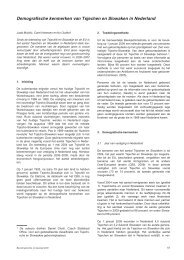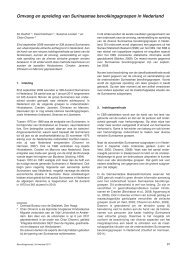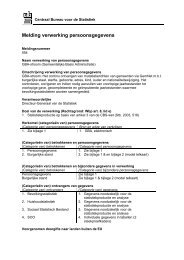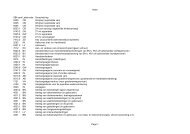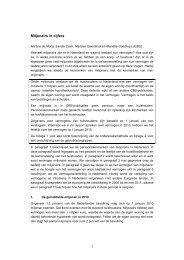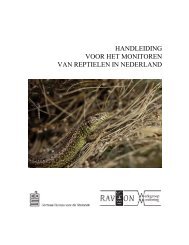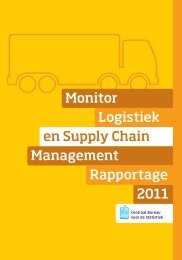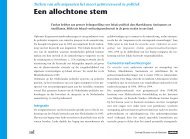Internationalisation monitor 2012 - CBS
Internationalisation monitor 2012 - CBS
Internationalisation monitor 2012 - CBS
Create successful ePaper yourself
Turn your PDF publications into a flip-book with our unique Google optimized e-Paper software.
Economic growth is predominantly concentrated in the developing countries. China,<br />
India, Brazil and Russia are rapidly gaining economic power. Their current and future<br />
growth opens up a huge potential for the trade and investment relations of Dutch<br />
firms. This chapter provides an overview of trade relations with the BRIC countries,<br />
and illustrates factors that may contribute or hamper trade with these fast-growing<br />
economies. It turns out that trade with BRIC is often carried out by large and<br />
medium-sized enterprises. BRIC traders are also characterised by higher productivity,<br />
foreign ownership and two-way trade.<br />
2.1 Introduction<br />
BRIC countries are increasingly important for the Dutch economy. The term BRIC is an<br />
acronym for the economies of Brazil, Russia, India and China, and it is used as a symbol<br />
of the shift in global economic power towards developing fast-growing countries. 1)<br />
Approximately 16 percent of Dutch imports originate from the BRIC countries. These<br />
imports are an important source for re-exports. Although exports to the BRICs are still at<br />
a modest level, the fast growth in the BRIC countries and the slow growth in Europe make<br />
it likely that the BRIC countries will become a more important market for exporting firms<br />
in years to come. This makes it relevant to gain insight in the enterprise characteristic of<br />
firms that are actively trading with the BRIC countries and to determine which factors or<br />
firm characteristics are crucial for success on the BRIC markets.<br />
Previous editions of the <strong>Internationalisation</strong> Monitor (<strong>CBS</strong> 2009, 2010, 2011) have shown<br />
that Dutch traders are larger firms than non-traders, that they pay higher wages, are more<br />
productive, and spend more on research and development. This is in line with current<br />
literature (Bernard and Jensen, 1997; Wagner, 2005). However, there is heterogeneity<br />
within trading firms. Two-way traders, who import as well as export, are more productive<br />
and pay higher wages than exporters or importers alone. Also, foreign owned enterprises<br />
are more productive than Dutch owned firms. The most recent research shows that the<br />
choice of destination markets is influenced by firm characteristics. Firms that mainly<br />
import from China/BRIC countries are on average the smallest, paying the lowest salaries<br />
(<strong>CBS</strong>, 2011).<br />
What are the other enterprise characteristics of BRIC traders? Which firm characteristics<br />
determine trade relations with BRIC? This chapter will fill the knowledge gap on<br />
1) The term BRIC was first used in a Goldman Sachs report from 2003 which speculated that by 2050 these four economies would<br />
be wealthier than most of the current major economic powers.<br />
46 Statistics Netherlands





